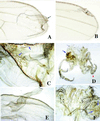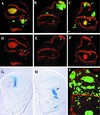Notch signaling directly controls cell proliferation in the Drosophila wing disc
- PMID: 10706613
- PMCID: PMC15976
- DOI: 10.1073/pnas.040576497
Notch signaling directly controls cell proliferation in the Drosophila wing disc
Abstract
Notch signaling is involved in cell differentiation and patterning during morphogenesis. In the Drosophila wing, Notch activity regulates the expression of several genes at the dorsal/ventral boundary, and this is thought to elicit wing-cell proliferation. In this work, we show the effect of clones of cells expressing different forms of several members of the Notch signaling pathway, which result in an alteration of Notch activity. The ectopic expression in clones of activated forms of Notch or of its ligands (Delta or Serrate) in the wing causes outgrowths associated with the appearance of ectopic wing margins. These outgrowths consist of mutant territories and of surrounding wild-type cells. However, the ectopic expression of Delta, at low levels in ventral clones, causes large outgrowths that are associated neither with the generation of wing margin structures nor with the expression of genes characteristic of the dorsal/ventral boundary. These results suggest that Notch activity is directly involved in cell proliferation, independently of its role in the formation of the dorsal/ventral boundary. We propose that the nonautonomous effects (induction of extraproliferation and vein differentiation in the surrounding wild-type cells) result from pattern accommodation to positional values caused by the ectopic expression of Notch.
Figures




References
Publication types
MeSH terms
Substances
LinkOut - more resources
Full Text Sources
Molecular Biology Databases

